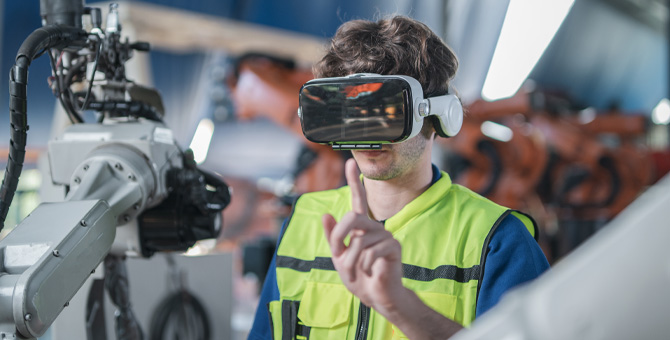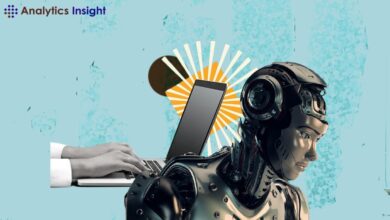Understanding How Artificial Intelligence is Changing Advanced Manufacturing and Other Sectors of the Economy

Communities and businesses play a crucial role in shaping the Federal Reserve’s monetary policy. To inform our decision-making, the San Francisco Fed hosts discussions with the people we serve so we can hear their stories and perspectives on how economic data translates into real impacts in the Twelfth District. Our “Beyond the Numbers” series shares some of those insights with you.
The San Francisco Fed, in close coordination with the Federal Reserve System Innovation Office, recently launched the EmergingTech Economic Research Network (EERN), a new initiative to better understand how emerging technologies like Generative Artificial Intelligence (GenAI) are shaping the economy of the future.
One of EERN’s chief goals is to develop deeper insights into how new technologies are being integrated into workplaces and across industries. To this end, we are engaging industry and community leaders in our district about how they are adopting AI tools in their businesses.
Recently, Mary Daly, President and CEO of the San Francisco Fed, Sunayna Tuteja, Senior Vice President and System Chief Innovation Officer for the Federal Reserve System, and Kevin Ortiz, co-head of EERN, sat down with CEOs and other executives from the Twelfth District’s manufacturing sector. In a wide-ranging conversation, they discussed GenAI’s impact on productivity and costs and the challenges and opportunities related to implementing it in the manufacturing process.
AI experimentation is widespread and accelerating
Kicking off the conversation, we asked the roundtable participants about how widely AI was being used in their specific businesses and throughout their respective industries. In response, the executives reported widespread experimentation with artificial intelligence tools, including GenAI, while noting that the actual integration of AI into established operations has been more limited.
According to the participants, they are experimenting with GenAI most frequently in office operations, e.g., generating marketing copy, manufacturing timelines, and product tagging. They noted that the technology is especially useful in completing tedious, high-volume tasks such as composing product descriptions.
As they move from experimenting with AI to deploying the tools as a permanent feature of their operations, the businesses are using a combination of vendor software with embedded AI tools and publicly available Large Language Model tools. Some roundtable participants reported that they are also creating new positions for specialists trained to use AI-based tools, although the demand for such skilled positions currently outstrips the number of available technicians and engineers.
The limits of AI in manufacturing
Even as they noted their accelerated testing of GenAI tools in some areas of their business operations, the executives also highlighted some real limits to using AI tools in the manufacturing process.
These limits apply especially to the physical aspects of advanced fabrication, for example, the precision machining of parts. As one roundtable participant noted, there are three primary reasons for this. First, there is not yet enough data to train GenAI tools for use in the manufacturing process. In addition, developing enough training data is made more difficult by the fact that companies must be careful to protect proprietary information from being used to train third-party and public GenAI tools. Finally, advanced manufacturing companies must meet exacting quality and physical safety standards. Existing GenAI technology cannot yet consistently meet these standards, creating reputational, physical, and economic risks for any company deploying them. This in turn is leading manufacturing companies to focus implementation efforts on lower value, less risky areas.
The participants also forecast that the integration of GenAI into advanced manufacturing will lag because of cost considerations. The machines used in the sector are very expensive and have lengthy lifespans. Before purchasing new AI-enabled machinery, manufacturers will first ensure that their earlier investments pay off by using their current machines through the end of their lifecycles.
GenAI is only the tip of the iceberg
While the current public discussion about artificial intelligence has focused almost exclusively on GenAI, roundtable participants stressed the other types of AI such as machine learning, pattern recognition tools, and robotics. As they noted, these and other tools have a well-established presence in manufacturing with clearly defined use cases and have delivered notable process and productivity enhancements over the years.
Nonetheless even in this area of AI, it is difficult to attract and retain enough adequately trained employees. The executives felt that workforce and academic training needed to increase to meet the demand for the advanced skills necessary to work with these technologies.
From emergent to established technology
Asked about AI’s future potential, one participant noted that although investments in GenAI technologies are expected to lead to significant productivity gains in manufacturing, these technologies will likely eliminate certain task-based roles and lead to small workforce reductions. This expectation was not universal, however, as several participants noted that any productivity enhancements associated with the implementation of GenAI tools would allow manufacturers to expand operations and production using their existing workforce. Participants also discussed the new types of jobs with new skill profiles that will be created.
As we expand EERN, we will continue to engage in conversations like these. The discussions provided by business and community leaders at the forefront of technological change are crucial as we work to advance the nation’s monetary, financial, and payment systems to support a strong economy for all Americans.



